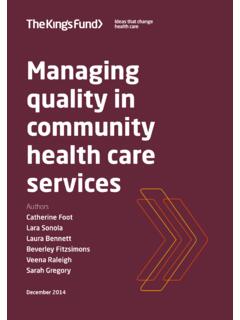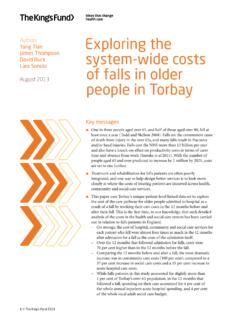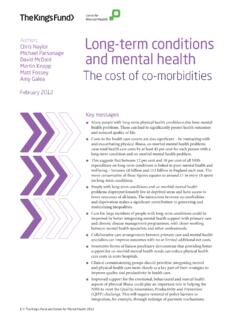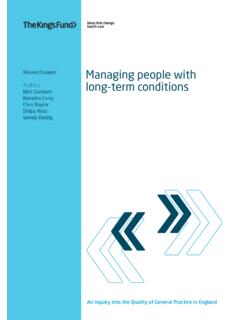Transcription of Case management: What it is and how it can best be ...
1 1 The King s Fund 2011 case managementWhat it is and how it can best be implemented Authors Shilpa Ross Natasha Curry Nick Goodwin November 2011 Key messagesn case management is an established tool in integrating services around the needs of individuals with long-term It is a targeted, community-based and pro-active approach to care that involves case -finding, assessment, care planning, and care The evidence for case management is mixed. However, where it is implemented effectively it has improved the experiences of users and carers, supporting better care outcomes, reducing the utilisation of hospital-based services, and enabling a more cost-effective approach to The following factors are linked to the achievement of successful outcomes.
2 N assigned accountability of an individual or team to the patients being case -managedn clarity about the role of the case managers and support to ensure they have the right clinical and managerial competenciesn accurate case -finding to ensure interventions target patients with defined care needsn appropriate caseloads to ensure that patients are receiving optimum caren a single point of access for assessment and a joint care plann continuity of care to reduce the risk of an unplanned admission to hospital n self-care, to empower patients to manage their own conditionn joined-up health and social care services with professionals working to aligned financial incentives and in multidisciplinary teamsn information systems that support communication, and data that is used pro-actively to drive quality case management works best as part of a wider programme of care in which multiple strategies are employed to integrate care.
3 These include good access to primary care services, supporting health promotion and primary prevention, and co-ordinating community-based packages for rehabilitation and re-ablement. 2 The King s Fund 2011 case managementIntroductionOver the next decade and beyond, broad shifts in demographics and disease status will mean that patients with long-term chronic conditions will absorb the largest, and growing, share of health and social care budgets. In order to meet this challenge, health and social care systems need to develop an approach that better co-ordinates and integrates services around the needs of patients and service users of all ages with chronic, medically complex and disabling conditions.
4 This is where the potential for delivering better and more cost-effective care is greatest. At a local level, the health and social care sectors have been developing innovations in integrated care for many years. However, while integrated care promises to deliver both better-quality care and cost benefits, the evidence about what works remains mixed, due to the variety of approaches that have been adopted. There is, moreover, a general lack of knowledge about how best to apply (and combine) the various approaches to delivering co-ordinated care in practice. The aims of this paperThis paper examines how case management can be implemented successfully. It is the first in a series of reports from The King s Fund that examine key strategies designed to improve the delivery of integrated care for people with long-term conditions.
5 In common with the other papers to be developed in this series, we draw on a review of the literature. Our aim is to provide an evidence-based resource to support commissioners and providers to implement case management as part of a wider strategy to provide better co-ordinated care for people with long-term conditions. The paper explores these key questions:n What is case management ?n What are the core components of a case management programme?n What are the benefits of case management when it is implemented effectively?n What factors need to be in place for successful case management ? What is case management ? case management is a generic term, with no single definition.
6 Hutt et al (2004) described it as the process of planning, co-ordinating and reviewing the care of an individual . The case management Society of America (CMSA) defines it as a collaborative process of assessment, planning, facilitation, care coordination, evaluation, and advocacy for options and services to meet an individual s and family s comprehensive health needs through communication and available resources to promote quality cost-effective outcomes (CMSA website). These definitions suggest that, rather than being a single intervention, case management refers to a package of care which covers a range of activities that can vary widely between programmes.
7 The absence of a single definition has led to confusion and uncertainty about what exactly case management involves. For instance, in some contexts it can refer to an ongoing programme of individualised care aimed at keeping people well: but in others it refers to an intensive, personalised and time-limited intervention aimed at preventing a specific occurrence or event usually an emergency hospital admission. In the NHS in England, there is some ambiguity over whether case management should be time-limited or ongoing (one Department of Health document suggests it should be ongoing (Department of Health 2005b)) case management usually refers to the latter, and so it is that definition we have used in this paper.
8 3 The King s Fund 2011 case managementCase management is a key strand of the Department of Health s model for caring for people with long-term conditions (Department of Health 2005). This recognises that people living with long-term conditions have a varying intensity of needs and that care should be targeted accordingly. The premise of the model is that targeted, proactive, community-based care is more cost-effective than downstream acute care. Time-limited case management is the level of care targeted at those with the greatest risk of emergency admission. People at lower risk of admission can be targeted with disease management programmes or support to self-manage, although both these elements may also form part of a case management programme.
9 Programmes can focus on a specific condition or group of conditions, but most often they are generic and aimed at individuals with complex needs. This paper explores generic case management ; it does not focus on case management for specific long-term conditions or diseases, or on specific episodes such as end of life, except where there are transferable lessons to be case management has been implemented in the NHS, it has largely taken the form of community-based programmes set up and funded by primary care trusts (PCTs) and typically (but not always) staffed by community matrons. Although the programme content may vary widely, the key aims have remained the same:n to reduce expensive hospital utilisation (principally in terms of emergency admissions but also in terms of length of stay)n to improve care outcomes for patientsn to enhance the patient are the core components of a case management programme?
10 Drawing on the work of Challis et al (2010), Kodner (2003), and our own review of the literature, the following core components are particularly important to case management programmes: n case -findingn assessmentn care planning n care co-ordination (usually undertaken by a case manager in the context of a multi-disciplinary team). This can include, but is not limited to:n medication managementn self-care supportn advocacy and negotiationn psychosocial supportn monitoring and case closure (in time-limited interventions).This categorisation might suggest that case management is a linear process with sequential elements. In practice, of course, it is much more complex.



















